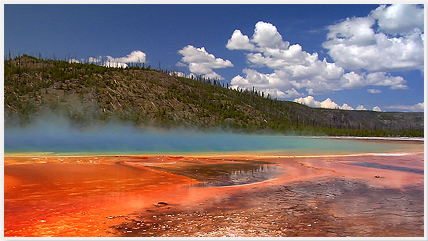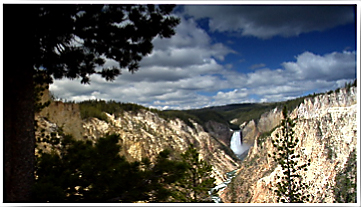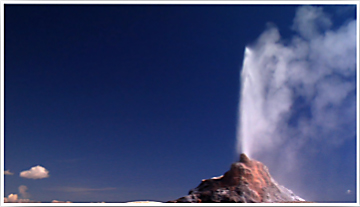Grand Prismatic Spring, Yellowstone National Park
Another of my favorite spots in Yellowstone is Grand Prismatic Spring. Grand Prismatic is the largest hot spring in Yellowstone. Only in New Zealand will you find two springs that are larger. The Hayden Expedition in 1871 named this spring because of its beautiful coloration. Early sketches of the springs seem so exaggerated that geologist A.C. Peale returned in 1878 to verify the colors.
The vivid colors in the spring are the result of pigmented bacteria in the microbial mats that grow around the edges of the mineral-rich water. The bacteria produce colors ranging from green to red; the amount of color in the microbial mats depends on the ratio of chlorophyll to carotenoids. In the summer, the mats tend to be orange and red, whereas in the winter the mats are usually dark green. The center of the pool is sterile due to extreme heat.
The deep blue color of the water in the center of the pool results from a light-absorbing overtone of the hydroxy stretch of water. Though this effect is responsible for making all large bodies of water blue, it is particularly intense in Grand Prismatic Spring because of the high purity and depth of the water in the middle of the spring.
The spring is approximately 250 by 300 feet (75 by 91 m) in size and is 160 feet (49 meters) deep. The spring discharges an estimated 560 gallons (2000 litres) of 160°F (71°C) water per minute.
You can view this clip here.







Do Pictures Lie?
What do you think of this picture?
It’s a beautiful picture isn’t it? One of those Golden Graham mornings.
How about this one?
Not quite the same impact is it? Would it surprise you to know that both pictures are at the same location? Would it surprise you even more to know that the “mountain” in the background is actually our local landfill “Mt. Trashmore”?
We’ve all heard the pictures never lie, but they do all the time. There’s an old mission in Montana that I’ve seen in books and magazines for many years. It shows this beautiful mission seemingly in the middle of nowhere with majestic mountains rising up behind it.
So one year, I made the trip to photograph the mission. As I travelled up the highway I happened to glance over to my right and there was this building that kind of looked like the mission. I was puzzled because this building was right in a town. There were telephone lines running every which way run down buildings, junk cars. It couldn’t be the same mission could it? Well, it just so happens that if you set up at just the right angle, you can eliminate all the distractions and get the iconic shot of the mission against the mountains that you see in all the magazines.
As a photographer and now filmmaker, I’ve learned that it’s not so much how things look but how you see the possibilities within them.
Here’s a shot from a recent short I did. It’s a tranquil pond seemingly set in a Waldenesque setting.

You can feel the peace and tranquility in this quiet little spot.
In actuality, this pond is in my housing development just off a major highway, Tons of traffic on the highway, dogs barking in people’s yards. It certainly wasn’t peaceful by any means.
This is what it normally looks like whenever I drive by.

Do pictures really lie? I don’t think they do. I think they can show us the possibilities that we’ve chosen not to see. They show, at least to me, that there is beauty everywhere. We just need to take the time to see it. I feel fortunate to be blessed with the ability to see beyond what’s in front of my eyes and find those possibilities that seemingly lie hidden away.